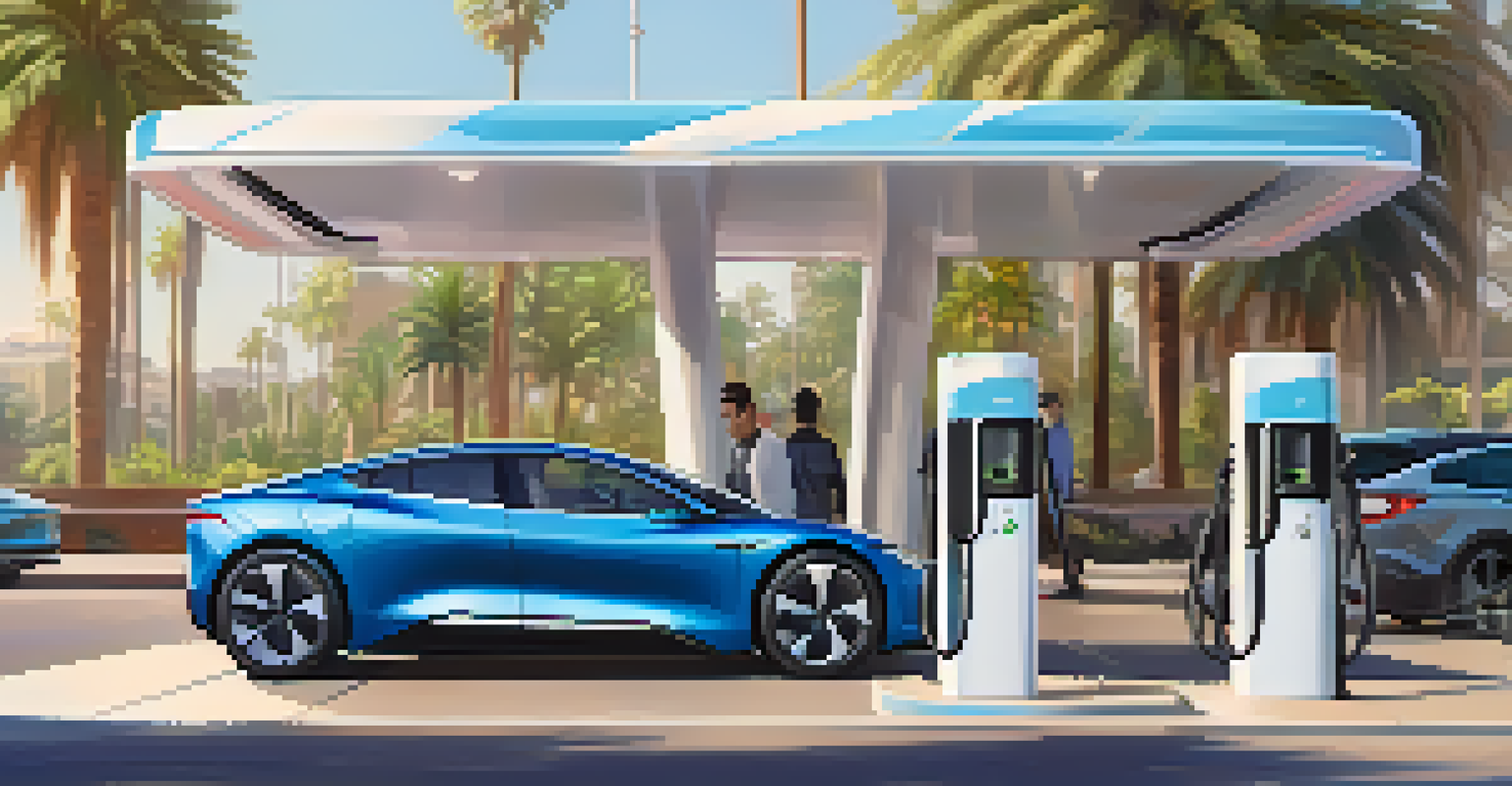California's Vision for a Sustainable Future in Transportation

California's Commitment to Sustainable Transportation Solutions
California has long been a leader in environmental initiatives, and transportation is no exception. The state aims to reduce greenhouse gas emissions and promote cleaner air through innovative transportation policies. This commitment is evident in ambitious plans that prioritize sustainability while enhancing mobility for residents.
The future will be green, and the future will be sustainable.
To achieve these goals, California has developed a multi-faceted approach that includes investment in public transit, electric vehicles (EVs), and active transportation options like biking and walking. By creating an integrated transportation system, the state seeks to reduce reliance on fossil fuels and improve the overall quality of life for its citizens. These strategies reflect a broad vision that encompasses economic growth alongside environmental stewardship.
Ultimately, California's commitment to sustainable transportation not only addresses climate change but also fosters community resilience. As the state continues to innovate, it sets a precedent for other regions to follow, demonstrating that a sustainable future is achievable through collective effort and visionary policy.
Investing in Electric Vehicle Infrastructure
A cornerstone of California's transportation vision is the expansion of electric vehicle (EV) infrastructure. With a target to have 1.5 million zero-emission vehicles on the road by 2025, the state is actively working to build a robust network of charging stations. This effort is crucial in making EVs a viable option for more drivers, reducing range anxiety and promoting widespread adoption.

In addition to increasing charging accessibility, California is also investing in incentives for purchasing EVs, such as rebates and tax breaks. This financial support makes transitioning to electric vehicles more appealing for consumers. Furthermore, the state is collaborating with automakers and tech companies to develop new technologies that enhance EV performance and efficiency.
Investing in EV Infrastructure
California is expanding its electric vehicle infrastructure to support the goal of 1.5 million zero-emission vehicles by 2025.
By prioritizing EV infrastructure, California is not only addressing environmental concerns but also stimulating economic growth. The development of charging stations creates jobs and encourages innovation in the green technology sector, positioning California as a leader in the transition to sustainable transportation.
Enhancing Public Transit Systems for Accessibility
Public transit is a key element in California's sustainable transportation strategy. By investing in buses, trains, and subways, the state aims to provide efficient and reliable options for commuters. This focus on public transit helps reduce traffic congestion and lowers carbon emissions, making daily commutes more environmentally friendly.
Sustainability is not a destination; it is a journey.
California is also working to improve the accessibility of its public transit systems. This includes ensuring that transit options are available to underserved communities, promoting equity in transportation access. By connecting these communities to job opportunities and essential services, the state fosters social inclusion while contributing to a more sustainable future.
Moreover, enhancing public transit can lead to a cultural shift in how Californians view transportation. By making public options more appealing and convenient, the state encourages residents to consider alternatives to driving, ultimately reducing the number of vehicles on the road.
Promoting Active Transportation: Walking and Biking
In addition to public transit and EVs, California is championing active transportation methods, such as walking and biking. By investing in bike lanes, pedestrian paths, and green spaces, the state aims to create a more walkable and bike-friendly environment. This not only benefits the environment but also promotes healthier lifestyles among residents.
California's commitment to active transportation is evident in various initiatives that encourage communities to embrace these modes of travel. Programs like 'Bike to Work Day' and the development of safe cycling routes help raise awareness and promote a culture of biking. These initiatives also contribute to reducing traffic congestion and improving air quality.
Enhancing Public Transit Access
The state is improving public transit systems to ensure reliable and equitable transportation options for all residents.
Furthermore, increasing the availability of active transportation options helps foster community engagement and social interaction. As more people choose to walk or bike, neighborhoods become more vibrant, creating a sense of belonging and connection among residents.
Innovating with Smart Transportation Technologies
Innovation plays a significant role in California's vision for sustainable transportation. The state is exploring smart transportation technologies that enhance efficiency and reduce environmental impact. This includes utilizing data analytics to optimize traffic flow and improve public transit scheduling, making the entire system more user-friendly.
Moreover, California is at the forefront of developing autonomous vehicle (AV) technology. By integrating AVs into the transportation ecosystem, the state aims to reduce traffic accidents and improve mobility for all, including those unable to drive. These advancements hold the potential to revolutionize how people navigate urban spaces.
As these technologies evolve, California is committed to ensuring they align with sustainability goals. By prioritizing eco-friendly innovations, the state lays the groundwork for a transportation future that is not only smarter but also greener.
Addressing Climate Change through Transportation Policies
Climate change is a pressing issue, and California recognizes the critical role transportation plays in addressing this challenge. The state's transportation policies are designed to reduce emissions significantly and promote sustainable practices. By integrating climate action into every aspect of transportation planning, California is paving the way for a more resilient future.
One of the key strategies involves setting strict emissions standards for vehicles and fostering the growth of clean energy sources. By transitioning to renewable energy for public transit and charging infrastructure, California aims to minimize the carbon footprint of its transportation systems. This holistic approach ensures that every layer of transportation contributes to climate goals.
Encouraging Active Transportation
California promotes walking and biking through investments in infrastructure like bike lanes and pedestrian paths to foster healthier lifestyles.
Furthermore, California's focus on climate resilience prepares the state for future challenges. By anticipating changes in climate and adapting transportation infrastructure accordingly, the state not only protects its investments but also safeguards the well-being of its residents.
Fostering Community Engagement and Collaboration
Creating a sustainable transportation system is not solely the responsibility of policymakers; community engagement is essential. California actively involves residents in the planning process, ensuring their voices are heard. Through public meetings, surveys, and outreach programs, the state fosters collaboration between communities and authorities.
This engagement allows for the development of transportation solutions that reflect the unique needs of each community. By understanding local challenges and opportunities, California can tailor its strategies effectively, resulting in greater buy-in from residents. This collaborative approach helps build trust and encourages a sense of ownership among community members.

Moreover, fostering community engagement enhances awareness about sustainable transportation options. As residents become informed about the benefits of public transit, biking, and walking, they are more likely to embrace these alternatives, ultimately contributing to a more sustainable transportation landscape.